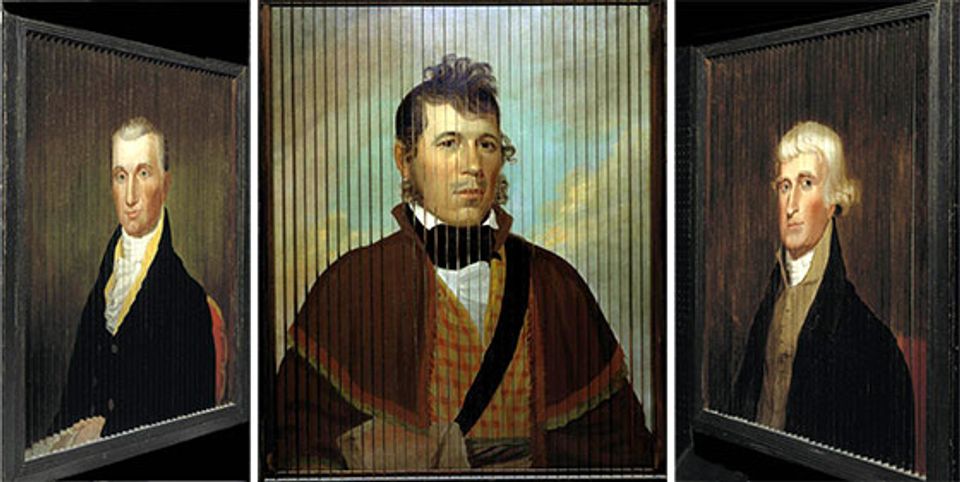
This post is part of an ongoing series on Eye Level: Q and Art, where American Art's Research department brings you interesting questions and answers about art and artists from our archive.
Question: Can you tell me more about Three-Way Portrait of Thomas Jefferson, James Monroe and Unidentified Native American? What is the history of this type of artwork?
Answer: The American Art Museum's three-way portrait is an unusual artwork that combines three portraits in one frame. The artist achieved this three-in-one construction by placing the portraits of Thomas Jefferson and James Monroe back-to-back and dividing it into strips. He then placed the strips perpendicular to the third portrait of the Unidentified Native American. When standing straight in front, the viewer sees the portrait of the Native American; from the right side the viewer sees the portrait of Thomas Jefferson, and from the left, James Monroe. A few details about this artwork remain a mystery: the name of the artist and the identity of one of the portrait subjects. However in the process of conserving the artwork, art conservator, Michael O'Malley examined it closely and was able to make a few conclusions.
Three-Way Portrait is unsigned, and without a signature or detailed history of the work it is difficult to determine the name of the artist. However, after carefully comparing the portraits, O'Malley determined, rather than being assembled from paintings by various artists, the three portraits were painted by one person. Also, it is likely that the portraits of Thomas Jefferson and James Monroe were painted from prints, but the detail included in the portrait of the unidentified Native American indicates that the artist painted this from life. Researchers have proposed that the unidentified portrait subject may be Chief William Mackintosh as the portrait in Three-Way Portrait resembles the image of Mackintosh published in McKenny and Hall's illustrated book History of the Indian Tribes of North America. During Monroe's presidency, Mackintosh was involved with issues of Native American land ownership.
Unfortunately, the written history of three-way pictures is sparse. Descriptions of similar two-way and three-way pictures in literature have been found as early as the 17th century. It is possible the Renaissance artists' renewed interest in perspective, the techniques used to depict three-dimensional objects on a flat surface, led to the production of two-way and three-way pictures. The more common two-way picture was made by placing two images cut into strips on alternating sides of a corrugated board. The art historian Allan Shickman argued that several Shakespeare plays include references to two-way pictures, and the pictures were familiar to audiences of the playwright's time. An example of a two-way picture is owned by the National Portrait Gallery of Scotland. During the 19th century in the United States, three-way pictures were used as advertisements, store signs and toys. Three-way pictures painted on wood and cloth, like the American Art Museum's piece, are rare, but there are more examples of three-way pictures made of paper. Catalogs of Currier and Ives prints include three-way prints, and examples of three-way pictures on paper are found in the Library of Congress and the Chicago History Museum.
To read more about the American Art Museum's Three-Way Portrait and similar works, look for the following articles online and at your library:
- "The Conservation of a Three-Way Painting" by Michael O'Malley, Journal of the International Institute for Conservation-Canadian Group Vol. 21 (1996), pgs. 3-8.
- "Turning Pictures in Shakespeare's England" by Allan Shickman, Art Bulletin, Vol. 59 (March 1977), pgs. 67-70.


















